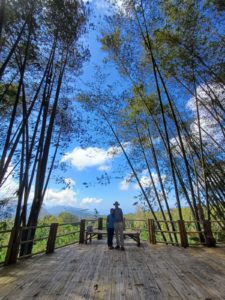As we spent most of our time in a car, it’s a bit of a push to include this post under “The Natural World,” but touristing in the island of Flores in eastern Indonesia is about as close as I could get. It saddens me that there have been so few posts in this category in the past year or two. I need to get out more. A lot more. I’ll be trading conspiracy theories if this computer-bound life goes on much longer.
For those who have never heard of Flores, click here for a rather dry wikipedia entry.
Our tour started in Ende, which lives up to its name at the end of the world haha.There we met Marino, who was to be our guide for the tour. He had dreadlocks down to his hips, but insisted that although he liked reggae music, he is not Rastafarian. Like most people from Flores (Floratians?), he is Catholic. As the trip went on, however, I began to suspect that the Catholicism was a thin veneer on a deep base of Animism.
Ende is an administrative centre whose main claim to fame is that Soekarno, the father of Indonesian independence during the colonial era and the country’s first president, stayed there for a few years in Indonesia’s run-up to independence. Indonesia’s motto translates to “Strength through Diversity”, and Soekarno, a Muslim, resided with a Dutch pastor. After independence, Soekarno asked the Dutchman if there was anything he’d like, and the Dutchman asked for and was granted Indonesian citizenship.
We departed Ende and turned up a gorge. I came to like Marino’s driving style. He rarely made it past third gear and the more he spoke, the slower we went. As I was happy with slow, this resulted in a running commentary that was both informative and funny. The road we were travelling along was the inter-Flores highway. Flores is about 350km from one end to the other, but the highway, constructed by the Dutch in 1925, is 720km long as it is “a spaghetti road” (jalan spageti). The cows tethered on the verge were there as a result of a central government project: Indonesia imports huge amounts of beef cattle every Ramadan and, as Floratians consume almost no beef, the idea was that the Floratians would husband the cattle and export them to Java. At one point we went past a shack with an enormous speaker stack on the porch: Floratians, when they celebrate, do so with loud music and lots of palm todi. We also went past a lot of discarded plastic bags and detritus, the curse of developing-nation roads. Education, lamented Marino.
Our first port of call was Kelimutu, a somewhat active volcano which has three crater lakes, each a different colour. The wiki article linked to has better photos than I could take. The local people believe that the spirits of the dead go to these craters, the young to one, the old to another and the evil to a third.
I wonder which of the latter two I’ll go to.
Despite a fair lashing of tourists, I enjoyed our quick walk up the summit, and a diversion through a forest trail on the way down. And the sunrise was nice, though my phone camera was too crappy to catch it. So here, as a consolation prize, is the view from our room on our return:
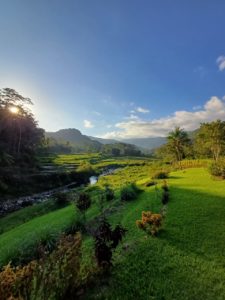
Rice paddies and hills, and very, very quiet.
In Flores, terraced rice paddies are an exception. The larger ethnic group in Flores seems to be the Bajo people, who never got the hang of terraced rice paddies. As Flores is very hilly, the Bajo people rely on potatoes, carrots, tubers, and any number of game animals for their diet – along with Flores chilies, which are not just spicy hot, but very tasty.
A consistent theme of this trip became that Floratians refused to believe that a foreigner (me!) would eat food at the same spice level they do. I can’t blame them. Although Flores is very far off the beaten path, I’ve noticed that distance from paths that are beaten doesn’t affect tourists’ diets. One time in Ladakh in India, a group of a dozen tourists sat at a table next to us. Rather than follow the Indian custom of ordering a variety of dishes and sharing, each ordered the same biryani, no one shared, and they left half the food uneaten. Click, got the photo of spectacular landscape, curious humanoids, but we’re not changing our diet or cultural eating patterns one little bit, seems to be the attitude. Their loss – but I suppose that’s what Floratians are used to. Hence a constant backwards-and-forwards regarding the spice in my food.
The next day was a medley. We started out with a walk through the jungle, with a very well-informed guide who pointed out all sorts of jungle plants. At one point, we (my wife and I) recognised the smell of mint. Our guide had never heard of it, but when we pointed out the plants, he told us that variety of mint was highly poisonous. We saw a cashew-nut tree and found out that the nuts grow on a fruit which is very tasty, and very, very sour. Refreshing to eat after a long walk, but not something most people would have in the dining room fruit bowl. The locals let the fruit rot but harvest the cashews. Our guide also pointed out cocoa nuts, which are suffering from a blight, and the Tiger Balm plant. South-East Asians place great reliance on Tiger Balm as a cure for everything from a sniffle to a broken leg to tertiary syphilis. Useless to me: I can’t abide the smell. He also pointed out how the local palm toddy is made – cut the branch from a certain type of palm, collect the sap in a bamboo tube, ferment and get shit-faced.
One of Flores’s major exports is coffee. I’d never seen a coffee tree before:
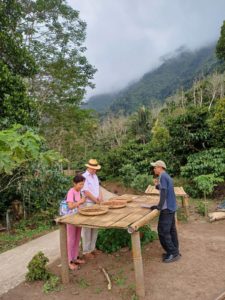
Here’s me learning about coffee from a young man just returned from university in Manchester, England. That particular plantation is second-generation, the current owner being an Indonesian who naturalised in Holland. She has great but rather vague plans for her plantation. I hope they come to fruition, whatever they are.
Just down the road we came to a village.
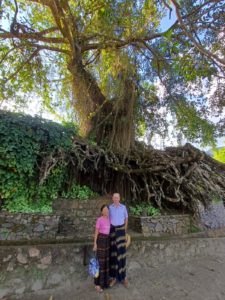
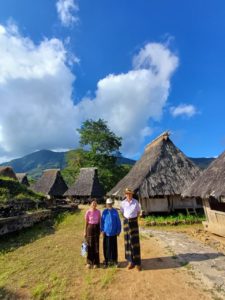
The boh-tree is a kind of marker for the villagers, who can become quite dispersed so need a reference point. As boh-trees live forever and are huge, so visible from a distance, they serve the purpose. The gentleman between my wife and me was the headman of the tribe. He was a former schoolteacher who spoke excellent English. He related this tale:
Once, an immigrant from Java had turned up and, without making any overtures of friendship to his village, built a house on their land. The village was very unhappy about this. As head, it fell upon him to do something about it. In prosecution of this, he sacrificed a dog, drank its blood, ate its liver and led the villagers to the offending house – which they torched. “That was five or six years ago,” he concluded. “The police have still never come.”
Moral: if you come to this part of the world and wish to reside, make friends with the villagers first.
The next day, after a spice-free meal at our beautiful but soulless tourist hotel in the rice padis, we set off west to Bajawa. The route there has two volcanoes which, according to the local people, are dad and mum:
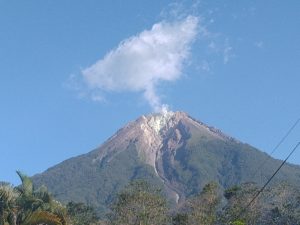
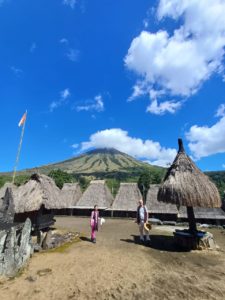
Dad, on the photo on the left, is a chain smoker of many years standing. Mum, was demure, so spent most of our visit modestly shrouded in the clothes of cloud, but she made a very brief appearance for the photo on the right. Dad and Mum were divorced by administrative fiat when the regency that contained both of them split. Thus do the affairs of bureaucrats afflict local custom.
The village in the foreground of the right-hand photo is of a different tribe to our dog-sacrificing warrior above, but the same overall Bajo people. The tribe in the Bajawa area is matriarchal. The only practical difference that makes seems to be when a woman of from one of the matriarchal clans falls in love with a man from one of the patriarchal ones and vice versa. What that seemed to boil down to was ostracism and very large numbers of water-buffalo as the dowry. Though Marino, our be-dreadlocked guide, didn’t use the word dowry.
Our next port of call was a waterfall. I’m not normally much of a waterfall sort of person, but this one involved descending an enormous number of steps to arrive at a natural stone bridge across the water:
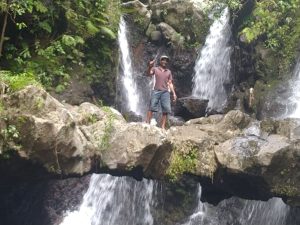
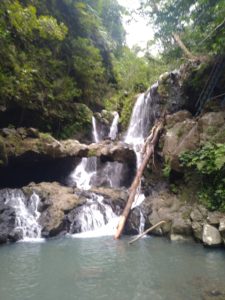
The photo on the left is the local guide showing it can be crossed. Marino took one look at this gratuitous display of foolhardiness and shook his head. As did I.
There were more waterfalls the next day. These had the distinction of running both hot and cold at the same time: they were at the confluence of two streams, one from a nearby hot springs which was hot and the other from distant cold rainwater, which was cold.
Marino explained that the person who lives nearby the waterfall had no idea that it could be a tourist attraction until Marino suggested it. The resident took his advice and now offers food (with chilies for a change!), along with the local firewater. That was a very good meal.
To the extent that Indonesia is ever in the news, it is normally about its appalling treatment of its own environment: the burning of forests in Sumatra, dangerous and cruel extraction of minerals, and the like. Don’t get me wrong: I think Indonesia would be a much happier and wealthier country if it were to preserve the magnificent rain forest and natural bounty to which the country is heir, treat its workers decently, and that Indonesia should be called out for the environmental vandalism and horrid working conditions.
But what tends to get overlooked in the international press is that a lot of Indonesians feel the same way. The rest of the world may be clueless as to where Indonesia is, but Indonesians are very well aware of what’s going on in the rest of the world, and many younger ones are keen to break ties with the extract-and-burn old guard. So the final delight of this trip was a bamboo university.
This is a small campus, built almost entirely from bamboo. There we learnt that there are three different types of bamboo, each with its own name in the local language, but which I will crudely translate as big, small and medium. The big ones are six inches or more in diameter and can bear structural loads, so are used for the columns and beams of the two-storey building at the centre of the campus. The medium ones are useful for household objects: they make excellent cups and the like. The small ones are used in a myriad of ways, including food (the pith, not the outside), matting, roofing and webbing.
The university is a private foundation. Indonesia is home to tens of thousands of foundations – its been my privilege to have engaged with a couple – and this reflects the country’s great and thriving civic society. (One that has largely come into being after Soekarno’s authoritarian successor, Suharto, was deposed in 1998.) Bajawa’s bamboo university was founded to teach local people how to cultivate bamboo as a cash crop, and to help them treat and find a market for the finished products.
And there we are, at the end of our tour:
